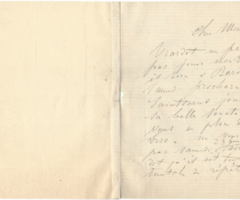Sonata for Cello and Piano no 1 in C minor op. 32
Allegro – Andante tranquillo sostenuto – Allegro moderato
In 1872, Saint-Saëns composed two major works for the cello: the Sonata op. 32 and the Concerto op. 33. Although he dedicated the chamber work to the cellist Jules-Bernard Lasserre, with whom he often performed, it was with Auguste Tolbecque (who was to give the first performance of the Concerto) that he premiered the piece on 7 December 1872, at the Société Nationale. In 1876, he performed the sonata again with its dedicatee at a concert in London. This tense, powerful work seems to recall the Franco-Prussian war of 1870. With its prevailing dark colours and vehement mood, the opening Allegro makes extensive use of the lower registers of both instruments. The second theme (a chordal melody in the upper register of the piano, while the cello seesaws between two notes) provides short-lived respite. The second movement introduces greater tranquillity. It is based on a chorale, about which Saint-Saëns originally said: “The Andante of my first sonata for piano and cello is the result of an improvisation on the organ at the church of Saint-Augustin; the first and last sections of the piece are a textual reproduction of what I improvised.” The central part is more Romantically expansive in nature, before developing the chorale’s head-motif which, in the last section of the movement, is swathed in graceful arabesques. The tempestuous finale reintroduces the mood from the beginning of the work, while a glimmer of hope is introduced by its second theme, a broad cantabile phrase. However, the uninterrupted onslaught of the piano drives the sonata into a headlong dash towards despair.

